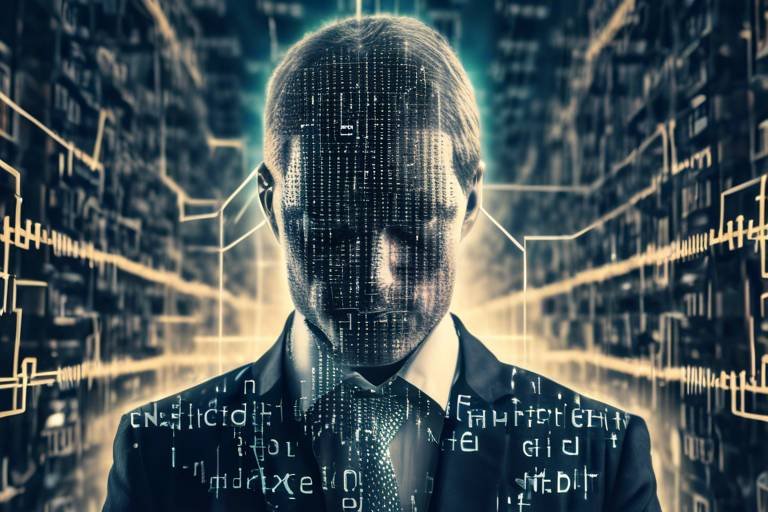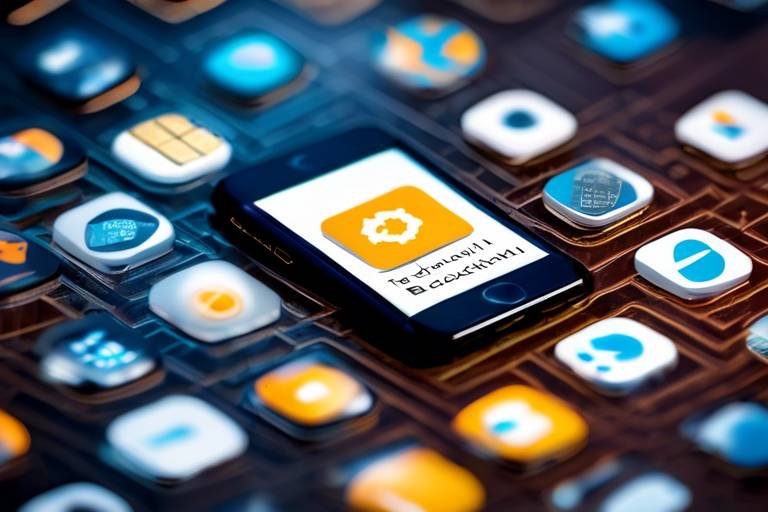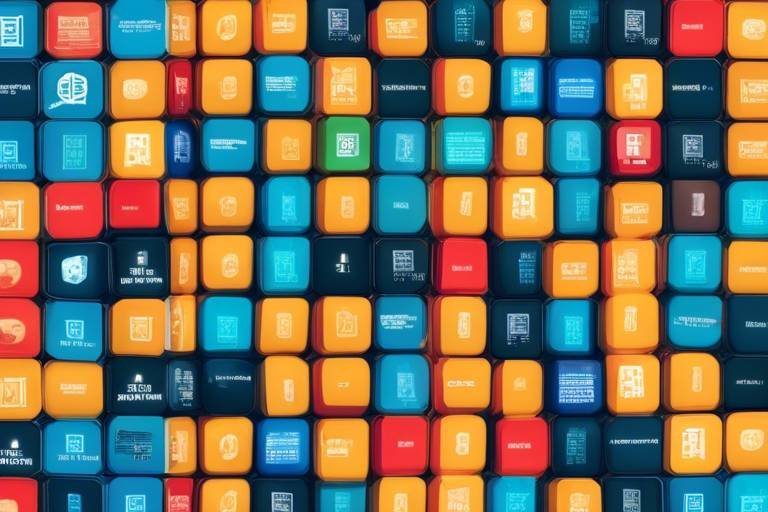How Blockchain Technology is Redefining Digital Ownership
In today's digital age, the concept of ownership is evolving at a breathtaking pace, largely thanks to blockchain technology. Imagine a world where your digital assets—be it art, music, or even virtual real estate—are securely owned and verifiable without the need for a middleman. This revolutionary technology is not just a buzzword; it’s a game-changer that is reshaping how we think about ownership in the digital realm.
At its core, blockchain is a decentralized ledger that records transactions across many computers, ensuring that the data is secure, transparent, and immutable. This means that once a transaction is recorded, it cannot be altered or deleted, providing a level of security that traditional systems simply cannot match. So, what does this mean for digital ownership? Well, it opens up a whole new world of possibilities!
Imagine owning a piece of digital art that you can prove is yours through a unique identifier on the blockchain. No more disputes over authenticity or ownership! This technology allows artists to create Non-Fungible Tokens (NFTs), which are unique digital assets that represent ownership of a specific item or piece of content. Think of NFTs as digital certificates of authenticity that you can buy, sell, or trade just like physical art, but with the added benefits of blockchain security.
Furthermore, blockchain technology is not limited to art. It has applications in various industries, from finance to real estate. For instance, in real estate, blockchain can streamline property transactions by providing a transparent and secure way to transfer ownership without the need for lengthy paperwork and intermediaries. This not only saves time but also reduces the risk of fraud.
As we continue to explore the implications of blockchain on digital ownership, we must also consider the challenges that come with it. Issues such as security vulnerabilities, scalability concerns, and regulatory frameworks need to be addressed to fully realize the potential of this technology. However, the benefits far outweigh the challenges, and as the technology matures, we can expect to see even more innovative applications that will redefine what it means to own something in the digital world.
- What is blockchain technology?
Blockchain is a decentralized digital ledger that records transactions across multiple computers securely and transparently. - How does blockchain ensure ownership?
Blockchain provides a unique identifier for each asset, making it easy to verify ownership without the need for intermediaries. - What are NFTs?
Non-Fungible Tokens (NFTs) are unique digital assets that represent ownership of a specific item or piece of content on the blockchain. - What challenges does blockchain face?
Challenges include security vulnerabilities, scalability issues, and the need for clear regulatory frameworks.

The Basics of Blockchain Technology
Understanding the fundamental principles of blockchain technology is essential for grasping its role in digital ownership. At its core, blockchain is a decentralized digital ledger that records transactions across multiple computers. This means that no single entity has control over the entire chain. Instead, every participant in the network maintains a copy of the entire ledger, which promotes transparency and security.
One of the most compelling features of blockchain is its immutability. Once a transaction is recorded on the blockchain, it cannot be altered or deleted. This creates a permanent record that can be trusted by all parties involved. Imagine a public library where every book is cataloged, and once a book is placed on the shelf, it stays there forever. This is akin to how blockchain operates, ensuring that every transaction is verifiable and traceable.
Another critical aspect of blockchain is its decentralization. Traditional databases are often controlled by a central authority, which can lead to issues like data manipulation and security breaches. In contrast, blockchain distributes control among its users. This decentralization not only enhances security but also fosters a sense of community and trust. Think of it as a potluck dinner where everyone brings a dish; no one person controls the meal, and everyone contributes to its success.
Blockchain operates through a consensus mechanism, which is the process used to achieve agreement on a single data value among distributed processes or systems. Two popular consensus mechanisms are Proof of Work (PoW) and Proof of Stake (PoS). PoW, used by Bitcoin, requires participants to solve complex mathematical problems to validate transactions and add them to the blockchain. On the other hand, PoS allows participants to validate transactions based on the number of coins they hold, making it a more energy-efficient option.
To summarize the key principles of blockchain technology, consider the following table:
| Principle | Description |
|---|---|
| Decentralization | No single entity controls the blockchain; it is distributed across multiple nodes. |
| Transparency | All transactions are visible to participants, enhancing trust. |
| Immutability | Once recorded, transactions cannot be altered or deleted. |
| Consensus Mechanism | Methods like PoW and PoS are used to validate transactions. |
In conclusion, blockchain technology serves as the backbone of digital ownership, providing a secure, transparent, and decentralized method of recording transactions. Its principles not only revolutionize how we perceive ownership in the digital realm but also pave the way for innovative applications across various industries. As we delve deeper into the world of digital assets, understanding these foundational concepts will be crucial for navigating the future of ownership.
- What is blockchain technology? Blockchain is a decentralized digital ledger that records transactions across multiple computers, ensuring transparency and security.
- How does blockchain ensure security? Blockchain's immutability means that once a transaction is recorded, it cannot be altered, creating a permanent and verifiable record.
- What are the main benefits of decentralization? Decentralization reduces the risk of data manipulation and security breaches by distributing control among users.
- What are consensus mechanisms? Consensus mechanisms are protocols that ensure all participants agree on the validity of transactions before they are added to the blockchain.

Digital Assets and Their Ownership
In today's digital age, the concept of ownership has undergone a seismic shift, thanks to the advent of blockchain technology. Digital assets, which range from cryptocurrencies to non-fungible tokens (NFTs), have emerged as valuable commodities, fundamentally altering how we perceive ownership in the digital realm. But what exactly are digital assets? Simply put, they are any items of value that exist in a digital format. This includes everything from virtual currencies to digital art and collectibles. The beauty of blockchain lies in its ability to provide a secure, transparent, and immutable ledger that verifies ownership, making it possible for individuals to truly own these digital assets.
One of the most significant implications of blockchain technology is that it allows for true ownership of digital assets. Traditionally, owning a digital item meant that you had a license to use it, but not necessarily the rights to sell or transfer it. With blockchain, however, ownership is encoded into the very fabric of the asset itself. When you purchase a digital asset on a blockchain, you receive a unique token that represents your ownership, which cannot be duplicated or altered. This revolutionary change empowers users, granting them rights that were previously unattainable in the digital landscape.
To illustrate how blockchain facilitates ownership, let’s take a closer look at two prominent types of digital assets: cryptocurrencies and NFTs. Cryptocurrencies like Bitcoin and Ethereum operate on decentralized networks, allowing for peer-to-peer transactions without the need for intermediaries. This means that when you send or receive cryptocurrency, the transaction is recorded on the blockchain, ensuring that both parties can verify ownership without relying on a third party.
On the other hand, NFTs have taken the art and collectibles market by storm. Unlike cryptocurrencies, which are fungible and can be exchanged for one another, NFTs are unique digital tokens that represent ownership of a specific item, whether it's a piece of digital art, music, or even virtual real estate. The ownership of an NFT is recorded on the blockchain, providing provenance and authenticity that can be traced back to the original creator. This has opened up new avenues for artists and collectors alike, allowing creators to monetize their work directly and collectors to invest in digital assets with confidence.
However, as we embrace this new frontier of digital ownership, it's essential to consider the implications and responsibilities that come with it. Ownership of digital assets means that individuals must also take on the responsibility of safeguarding their investments. The decentralized nature of blockchain technology means that there is no central authority to turn to in case of theft or fraud. Therefore, understanding how to securely store and manage digital assets is crucial.
In summary, blockchain technology is redefining digital ownership by providing a framework that allows individuals to possess and control their digital assets genuinely. The implications of this shift are profound, affecting various industries and creating new opportunities for innovation. As we move forward, it will be fascinating to see how this technology evolves and continues to shape our understanding of ownership in the digital world.
- What are digital assets? Digital assets are items of value that exist in a digital format, including cryptocurrencies and NFTs.
- How does blockchain ensure true ownership? Blockchain provides a secure and immutable ledger that verifies ownership, allowing individuals to truly own their digital assets.
- What is the difference between cryptocurrencies and NFTs? Cryptocurrencies are fungible digital currencies, while NFTs are unique tokens representing ownership of specific digital items.
- What responsibilities come with owning digital assets? Owners must safeguard their digital assets, as there is no central authority to help in case of theft or fraud.

Cryptocurrencies as Digital Currency
In recent years, cryptocurrencies have emerged as a revolutionary form of digital currency, fundamentally altering the way we think about money and transactions. Unlike traditional currencies that are issued and regulated by governments, cryptocurrencies operate on a decentralized network of computers. This decentralization is a game-changer, as it allows for peer-to-peer transactions without the need for intermediaries like banks. Imagine sending money to a friend across the globe with just a few clicks, without the hefty fees and delays associated with conventional banking systems. Sounds too good to be true? Well, that’s the reality cryptocurrencies offer!
At the heart of this transformation is blockchain technology, which ensures that every transaction is securely recorded on a public ledger. This means that once a transaction is made, it cannot be altered or deleted, providing an unprecedented level of transparency and trust in the system. Think of it as a digital vault where every transaction is etched in stone, visible to all but tamper-proof. This characteristic not only enhances security but also reduces the risk of fraud, making cryptocurrencies an attractive option for users worldwide.
Furthermore, cryptocurrencies come in different forms, each with its unique features and benefits. For instance, Bitcoin, the pioneer of cryptocurrencies, introduced the concept of a decentralized currency, while Ethereum expanded on this idea by enabling smart contracts—self-executing contracts with the terms directly written into code. These innovations have opened up a plethora of opportunities for businesses and individuals alike.
To better understand the impact of cryptocurrencies, let's take a look at some of their key advantages:
- Lower Transaction Costs: Traditional banking systems often impose high fees for international transactions. Cryptocurrencies significantly reduce these costs, allowing users to keep more of their money.
- Accessibility: Anyone with internet access can participate in the cryptocurrency market, breaking down barriers for the unbanked population around the world.
- Speed: Transactions can be processed in minutes, regardless of geographical location, making it an efficient alternative for cross-border payments.
However, it’s essential to recognize that the rise of cryptocurrencies isn't without its challenges. Issues such as market volatility, regulatory scrutiny, and security concerns can pose risks to users. For instance, the value of cryptocurrencies can fluctuate dramatically within short periods, leading to potential losses for investors. Moreover, the lack of regulation can attract malicious actors, making it crucial for users to stay informed and cautious.
In conclusion, cryptocurrencies are redefining the concept of digital currency, providing a secure, efficient, and decentralized alternative to traditional financial systems. As more people embrace this new form of currency, it will be fascinating to see how it continues to evolve and shape the future of finance.
- What is a cryptocurrency? A cryptocurrency is a digital or virtual currency that uses cryptography for security and operates on a technology called blockchain.
- How do I buy cryptocurrencies? You can buy cryptocurrencies through exchanges, where you can trade traditional currencies for digital ones.
- Are cryptocurrencies safe to use? While cryptocurrencies offer enhanced security features, they are not entirely risk-free. Users should be aware of potential fraud and market volatility.

Bitcoin: The Pioneer of Digital Currency
Bitcoin, often dubbed the pioneer of digital currency, made its grand entrance into the world in 2009, thanks to the mysterious figure known as Satoshi Nakamoto. This revolutionary creation was not just about creating a new form of money; it was about redefining the very concept of ownership and trust in the digital realm. Imagine a world where transactions could be made without the need for a middleman, where trust is built into the system itself—this is exactly what Bitcoin aimed to achieve.
At its core, Bitcoin operates on a decentralized network of computers, also known as nodes, which collectively maintain a public ledger called the blockchain. This blockchain is a transparent and immutable record of all transactions that have ever occurred, making it virtually impossible to alter or counterfeit. Think of it as a digital vault where every transaction is securely locked away, visible to everyone but accessible only to the rightful owner. This level of transparency is a game-changer, fostering trust among users and eliminating the need for traditional banks.
One of the most significant aspects of Bitcoin is its limited supply. Unlike traditional fiat currencies, which can be printed at will by governments, Bitcoin is capped at 21 million coins. This scarcity mimics precious metals like gold, making Bitcoin a digital form of "hard money." As demand increases and supply remains fixed, the value of Bitcoin has the potential to skyrocket, leading many to view it as a viable investment.
The impact of Bitcoin extends beyond just being a currency; it has sparked a revolution in how we perceive value in the digital age. Here are a few key points that highlight its significance:
- Peer-to-Peer Transactions: Bitcoin allows users to send and receive funds directly without intermediaries, reducing transaction fees and increasing efficiency.
- Global Accessibility: Anyone with an internet connection can access Bitcoin, making it a powerful tool for financial inclusion, especially in unbanked regions.
- Innovation Catalyst: Bitcoin has inspired a wave of innovation, leading to the development of thousands of alternative cryptocurrencies and blockchain applications.
However, Bitcoin's journey has not been without challenges. Its price volatility has raised eyebrows, and regulatory scrutiny has become more pronounced as governments grapple with how to address this new form of currency. Additionally, the environmental impact of Bitcoin mining has sparked debates about sustainability and energy consumption. Yet, despite these hurdles, Bitcoin remains a beacon of hope for many, symbolizing freedom from traditional financial systems.
In conclusion, Bitcoin is more than just a digital currency; it is a movement that has redefined the concept of ownership in the digital world. Its ability to empower individuals, foster transparency, and challenge the status quo makes it a pivotal player in the future of finance. As we continue to explore the possibilities that Bitcoin and blockchain technology offer, one thing is clear: the revolution has only just begun.
Q1: What is Bitcoin?
A1: Bitcoin is a decentralized digital currency that allows peer-to-peer transactions over a secure network known as blockchain.
Q2: How does Bitcoin ensure security?
A2: Bitcoin uses cryptographic techniques to secure transactions and control the creation of new units, making it highly secure and resistant to fraud.
Q3: What are the benefits of using Bitcoin?
A3: Benefits include lower transaction fees, global accessibility, and the ability to maintain financial privacy.
Q4: Is Bitcoin legal?
A4: The legality of Bitcoin varies by country. While some nations embrace it, others impose restrictions or outright bans.

Alternative Cryptocurrencies and Their Impact
When we think of cryptocurrencies, Bitcoin often steals the spotlight as the original and most recognized digital currency. However, the world of alternative cryptocurrencies, often referred to as "altcoins," is vast and vibrant, offering a plethora of options that cater to various needs and interests. Each altcoin has its own unique features, use cases, and communities, which contribute to a dynamic ecosystem that is rapidly evolving. This diversity not only enhances the overall market but also provides users with more choices for investment and utility.
For instance, Ethereum, one of the most prominent altcoins, introduced the concept of smart contracts, which are self-executing contracts with the terms of the agreement directly written into code. This innovation has opened up a world of possibilities for decentralized applications (dApps) and decentralized finance (DeFi), allowing developers to create platforms that operate without intermediaries. Imagine a world where you can lend or borrow money without a bank acting as a middleman; that’s the power of Ethereum and its smart contracts!
Another interesting player in the altcoin arena is Ripple (XRP), which focuses on facilitating cross-border payments. By enabling faster and cheaper transactions compared to traditional banking systems, Ripple is redefining how money moves around the globe. This is particularly beneficial for businesses that operate internationally, as it can significantly reduce transaction costs and time.
Moreover, there are altcoins like Litecoin and Dash that aim to improve upon Bitcoin’s transaction speed and efficiency. Litecoin, often dubbed the "silver to Bitcoin’s gold," offers quicker transaction times and a different hashing algorithm, making it a popular choice among users who prioritize speed. Similarly, Dash focuses on privacy and anonymity, allowing users to make transactions that are less traceable than those on more public blockchains.
Here’s a quick comparison of some notable altcoins:
| Cryptocurrency | Main Feature | Use Case |
|---|---|---|
| Ethereum (ETH) | Smart Contracts | Decentralized Applications |
| Ripple (XRP) | Cross-Border Payments | International Transactions |
| Litecoin (LTC) | Faster Transactions | Peer-to-Peer Payments |
| Dash (DASH) | Privacy Features | Anonymous Transactions |
The rise of alternative cryptocurrencies has also sparked a surge in investment opportunities. Investors are no longer limited to Bitcoin; they can explore a range of altcoins that might offer higher returns or align more closely with their values and interests. However, with this increased opportunity comes a level of risk. The volatility of altcoins can be significantly higher than that of Bitcoin, making it essential for investors to conduct thorough research and stay informed about market trends.
In conclusion, alternative cryptocurrencies are not just mere substitutes for Bitcoin; they are integral to the broader cryptocurrency landscape. They challenge the status quo, offering innovative solutions and new functionalities that can potentially transform industries. As blockchain technology continues to evolve, so too will the impact of these altcoins, paving the way for a more inclusive and diversified digital economy.

Non-Fungible Tokens (NFTs)
In recent years, have taken the digital world by storm, revolutionizing the way we perceive ownership of digital assets. Unlike cryptocurrencies such as Bitcoin or Ethereum, which are fungible and can be exchanged on a one-to-one basis, NFTs are unique digital tokens that represent ownership of a specific item or piece of content. This uniqueness is what makes them so appealing to artists, collectors, and investors alike. Imagine owning a rare piece of art or a limited edition collectible, but in a digital format; that’s the essence of NFTs.
So, how do NFTs actually work? At their core, NFTs are built on blockchain technology, which ensures that each token is verifiably unique and cannot be replicated. When an artist creates a digital artwork and mints it as an NFT, they are essentially creating a digital certificate of authenticity that proves their ownership and the originality of the piece. This is particularly significant in the art world, where provenance and authenticity are crucial. With NFTs, artists can sell their work directly to consumers, bypassing traditional galleries and auction houses, which often take hefty commissions.
Moreover, NFTs open up a world of possibilities for creators. Artists can include smart contracts in their NFTs, allowing them to earn royalties every time their work is resold in the secondary market. This means that artists can continue to benefit financially from their creations long after the initial sale, something that was nearly impossible in the traditional art market. For example, if a digital artist sells an NFT for $1,000 and it later sells for $10,000, the original artist could earn a percentage of that sale through the smart contract.
NFTs are not limited to digital art; they can represent a wide array of digital assets, including:
- Music and audio files
- Virtual real estate
- In-game items
- Sports memorabilia
- Collectible trading cards
However, with great potential comes great responsibility. As the NFT market continues to grow, so do concerns regarding copyright infringement and the environmental impact of blockchain technology. Many NFTs are minted on energy-intensive blockchains, raising questions about sustainability. Additionally, the rapid rise of NFTs has led to a surge in scams and fraudulent activities, making it essential for buyers to conduct thorough research before making any purchases.
In conclusion, NFTs are redefining the concept of ownership in the digital realm. They empower creators, provide new opportunities for collectors, and challenge traditional notions of art and value. As we continue to navigate this uncharted territory, it’s crucial to stay informed and cautious. The world of NFTs is still young, and who knows what surprises it holds for us in the future?
- What is an NFT? An NFT, or Non-Fungible Token, is a unique digital asset that represents ownership of a specific item or piece of content on the blockchain.
- How do I buy an NFT? To buy an NFT, you typically need a digital wallet and some cryptocurrency. You can purchase NFTs on various online marketplaces that specialize in digital assets.
- Are NFTs a good investment? Like any investment, NFTs come with risks. It's essential to do your research and understand the market before investing in NFTs.
- Can I create my own NFT? Yes! Anyone can create an NFT by minting it on a blockchain. Various platforms provide tools for artists and creators to easily mint their digital assets.

Challenges in Digital Ownership
Even though blockchain technology offers a revolutionary approach to digital ownership, it’s not all sunshine and rainbows. There are significant challenges that need to be addressed for it to reach its full potential. Think of it like climbing a mountain; the view from the top is breathtaking, but the journey can be rocky and filled with obstacles. Let's dive into the key challenges that are currently shaping the landscape of digital ownership.
One of the foremost issues is security and fraud risks. While blockchain is often touted as a secure way to store data, it’s important to recognize that vulnerabilities still exist. Imagine a digital vault; even the strongest vaults can have weak points. Hackers have become increasingly sophisticated, and while the blockchain itself is decentralized and immutable, the platforms built on top of it can be susceptible to attacks. Users must remain vigilant and take proactive measures to safeguard their digital assets. For instance, using hardware wallets and enabling two-factor authentication can significantly reduce the risk of fraud.
Another challenge that looms large is the regulatory and legal considerations. As blockchain technology evolves, so too do the laws and regulations surrounding it. Governments worldwide are grappling with how to regulate cryptocurrencies and digital assets effectively. This creates a landscape filled with uncertainties. For example, in some jurisdictions, the legal status of cryptocurrencies and NFTs remains ambiguous, leaving users in a state of confusion about their rights. It’s akin to navigating a maze without a map; one wrong turn could lead to serious consequences. Therefore, having clear and comprehensive regulations is essential for fostering trust and stability in the market.
Furthermore, scalability poses another hurdle. Blockchain networks can face performance issues as they grow. Picture a busy highway during rush hour; the more cars there are, the slower the traffic moves. Similarly, as more users join a blockchain network, transaction speeds can decrease, leading to delays and higher fees. This can be particularly problematic for applications requiring quick and efficient transactions, such as in the finance sector. Solutions like layer-2 scaling and sharding are being explored, but they are still in development stages and may take time to implement effectively.
In addition to these challenges, there’s also the issue of user education. Many individuals are still unfamiliar with blockchain technology and its implications for digital ownership. This lack of understanding can lead to poor decision-making, resulting in lost assets or missed opportunities. Educating users about how blockchain works, the importance of private keys, and the risks involved in trading digital assets is crucial. Just like learning to ride a bike, it takes time and practice to become proficient, and the same applies to navigating the world of blockchain.
To sum up, while blockchain technology is reshaping digital ownership in exciting ways, it also brings along a set of challenges that must be addressed. From security risks and regulatory uncertainties to scalability issues and the need for user education, there’s a lot to consider. However, with ongoing advancements and a proactive approach from both developers and users, these challenges can be overcome, paving the way for a more secure and efficient digital ownership landscape.
- What is blockchain technology? Blockchain technology is a decentralized digital ledger that records transactions across many computers, ensuring that the data cannot be altered retroactively.
- How does blockchain ensure security? Blockchain uses cryptographic techniques to secure data, making it nearly impossible to alter or hack without detection.
- What are the main challenges of digital ownership? The main challenges include security risks, regulatory uncertainties, scalability issues, and the need for user education.
- How can I protect my digital assets? Use hardware wallets, enable two-factor authentication, and stay informed about the latest security practices.

Security and Fraud Risks
When it comes to blockchain technology, one might envision an impenetrable fortress of digital security. However, the reality is a bit more complex. While blockchain is renowned for its decentralization and transparency, it does not mean that it is completely free from security vulnerabilities or fraud risks. In fact, as the popularity of digital assets grows, so do the tactics employed by cybercriminals looking to exploit weaknesses in the system.
One of the most significant risks associated with blockchain technology is the potential for hacking. Even though the blockchain itself is highly secure, the platforms and exchanges that facilitate the buying, selling, and trading of digital assets can be vulnerable. For instance, if a hacker gains access to an exchange's wallet, they can potentially steal millions in cryptocurrencies. This is why it's critical for users to choose reputable platforms and to implement strong security measures, such as two-factor authentication and strong passwords.
Moreover, phishing attacks are another common threat in the blockchain space. Cybercriminals often use deceptive emails or websites that closely resemble legitimate platforms to trick users into providing their private keys or other sensitive information. According to a recent report, phishing attacks in the cryptocurrency space have seen a significant uptick, with losses amounting to millions of dollars. Therefore, it's essential for users to remain vigilant and to verify the authenticity of any communication they receive.
In addition to hacking and phishing, smart contract vulnerabilities can also pose significant risks. Smart contracts, which are self-executing contracts with the terms of the agreement directly written into code, are a fundamental aspect of many blockchain applications. However, if these contracts contain bugs or flaws, they can be exploited by malicious actors. For example, the infamous DAO hack in 2016 resulted in the loss of approximately $60 million worth of Ether due to a vulnerability in its smart contract code. This incident highlighted the importance of rigorous testing and auditing of smart contracts before they are deployed.
To further illustrate the potential risks, consider the following table, which outlines some common security threats in the blockchain ecosystem:
| Security Threat | Description | Mitigation Strategies |
|---|---|---|
| Hacking | Unauthorized access to exchanges or wallets leading to theft of assets. | Use reputable platforms, enable two-factor authentication, and regularly update security protocols. |
| Phishing | Deceptive attempts to acquire sensitive information through fake emails or websites. | Verify the source of communications and avoid clicking on suspicious links. |
| Smart Contract Vulnerabilities | Exploiting bugs or flaws in smart contract code to manipulate outcomes. | Conduct thorough audits and testing of smart contracts before deployment. |
In conclusion, while blockchain technology offers revolutionary potential for digital ownership, it is not without its challenges. Users must remain aware of the security risks and take proactive measures to protect their digital assets. By understanding these threats and implementing robust security practices, individuals can enjoy the benefits of blockchain technology while minimizing their exposure to fraud and theft.
- What is blockchain technology?
Blockchain technology is a decentralized digital ledger that records transactions across many computers, ensuring that the records cannot be altered retroactively. - How does blockchain ensure security?
Blockchain uses cryptographic techniques to secure data and relies on a consensus mechanism to validate transactions, making it highly resistant to tampering. - What are smart contracts?
Smart contracts are self-executing contracts with the terms directly written into code, which automatically execute when predetermined conditions are met. - How can I protect my digital assets?
To protect your digital assets, use strong passwords, enable two-factor authentication, and be cautious of phishing attempts and suspicious links.

Regulatory and Legal Considerations
As blockchain technology continues to evolve, it brings along a whirlwind of that are crucial for both users and stakeholders. The decentralized nature of blockchain can pose unique challenges for governments and regulatory bodies, as traditional legal frameworks often struggle to keep pace with this rapid innovation. Imagine trying to catch a speeding train with a bicycle; that’s how regulators often feel when dealing with blockchain.
One of the primary concerns is the lack of clear guidelines governing digital assets. Different countries have adopted varying approaches, leading to a patchwork of regulations that can be confusing for users and businesses alike. For example, while some nations embrace cryptocurrencies, others impose strict bans or heavy taxation, making it difficult for entrepreneurs to navigate the landscape. This inconsistency can stifle innovation and deter investment.
Moreover, the legal status of non-fungible tokens (NFTs) remains ambiguous in many jurisdictions. Are they considered art, collectibles, or something entirely different? This uncertainty can lead to disputes over ownership and intellectual property rights. For artists and collectors, the implications are significant; without clear legal protections, their investments could be at risk. It’s like trying to own a piece of land without knowing if the title is valid – you might end up in a legal quagmire.
Another pressing issue is compliance with anti-money laundering (AML) and know-your-customer (KYC) regulations. As blockchain allows for anonymity in transactions, regulators are increasingly vigilant about ensuring that these technologies are not exploited for illicit activities. This has led to a push for more stringent regulations, requiring platforms to implement robust identity verification processes. While these measures are essential for maintaining the integrity of the financial system, they can also create hurdles for users who value privacy.
In addition to these challenges, there is the question of consumer protection. Many users entering the blockchain space are unaware of the risks involved, including the potential for fraud and loss of assets. Regulatory bodies are tasked with ensuring that consumers are adequately informed and protected from scams. This is particularly important in the realm of investment, where the volatility of cryptocurrencies can lead to significant financial loss.
To address these regulatory challenges, many experts advocate for a collaborative approach between blockchain innovators and regulatory authorities. By working together, they can develop frameworks that foster innovation while ensuring compliance and protection for users. This could involve establishing clear definitions for digital assets, creating standardized reporting requirements, and promoting transparency across the industry.
In conclusion, as blockchain technology continues to redefine digital ownership, the regulatory landscape will need to adapt. It’s a complex dance between innovation and regulation, where both sides must find common ground to ensure a secure and thriving digital economy. The future of blockchain will depend on how effectively these regulatory challenges are met, paving the way for a more transparent and equitable digital ownership model.
- What are the main regulatory challenges facing blockchain technology?
The main challenges include a lack of clear guidelines, compliance with AML and KYC regulations, and issues surrounding consumer protection.
- How do different countries regulate cryptocurrencies?
Countries vary widely in their approach, with some embracing cryptocurrencies and others imposing strict bans or heavy taxation.
- What is the legal status of NFTs?
The legal status of NFTs is still ambiguous in many jurisdictions, leading to potential disputes over ownership and intellectual property rights.
Frequently Asked Questions
- What is blockchain technology?
Blockchain technology is a decentralized digital ledger that records transactions across many computers. This ensures that the recorded transactions cannot be altered retroactively, providing a high level of transparency and security.
- How does blockchain redefine digital ownership?
Blockchain allows for true ownership of digital assets by providing a secure and transparent way to verify and transfer ownership. This is particularly important for assets like cryptocurrencies and NFTs, where traditional ownership models fall short.
- What are cryptocurrencies?
Cryptocurrencies are digital currencies that use cryptography for security and operate on blockchain technology. They enable peer-to-peer transactions without the need for intermediaries, which can redefine traditional financial systems.
- What is an NFT?
A Non-Fungible Token (NFT) is a unique digital asset that represents ownership of a specific item or piece of content, often art or collectibles. Unlike cryptocurrencies, NFTs are not interchangeable, making them ideal for representing unique ownership.
- What are the benefits of using blockchain for digital ownership?
Using blockchain for digital ownership offers several benefits, including enhanced security, transparency in transactions, and the ability to prove ownership without relying on a central authority. This can significantly reduce fraud and increase trust among users.
- What challenges does blockchain face in redefining ownership?
Despite its advantages, blockchain technology faces challenges such as security vulnerabilities, scalability issues, and regulatory uncertainties. These challenges can impact the widespread adoption and effectiveness of blockchain in various industries.
- How secure is blockchain technology?
While blockchain is generally considered secure due to its decentralized nature and cryptographic principles, it is not immune to risks. Users must still take precautions to protect their digital assets from potential fraud and cyberattacks.
- What are the legal implications of digital ownership?
The legal landscape surrounding digital ownership is still evolving. As blockchain technology grows, so do the regulatory frameworks that govern it. It’s essential for users to stay informed about legal considerations to ensure compliance and protect their assets.



















